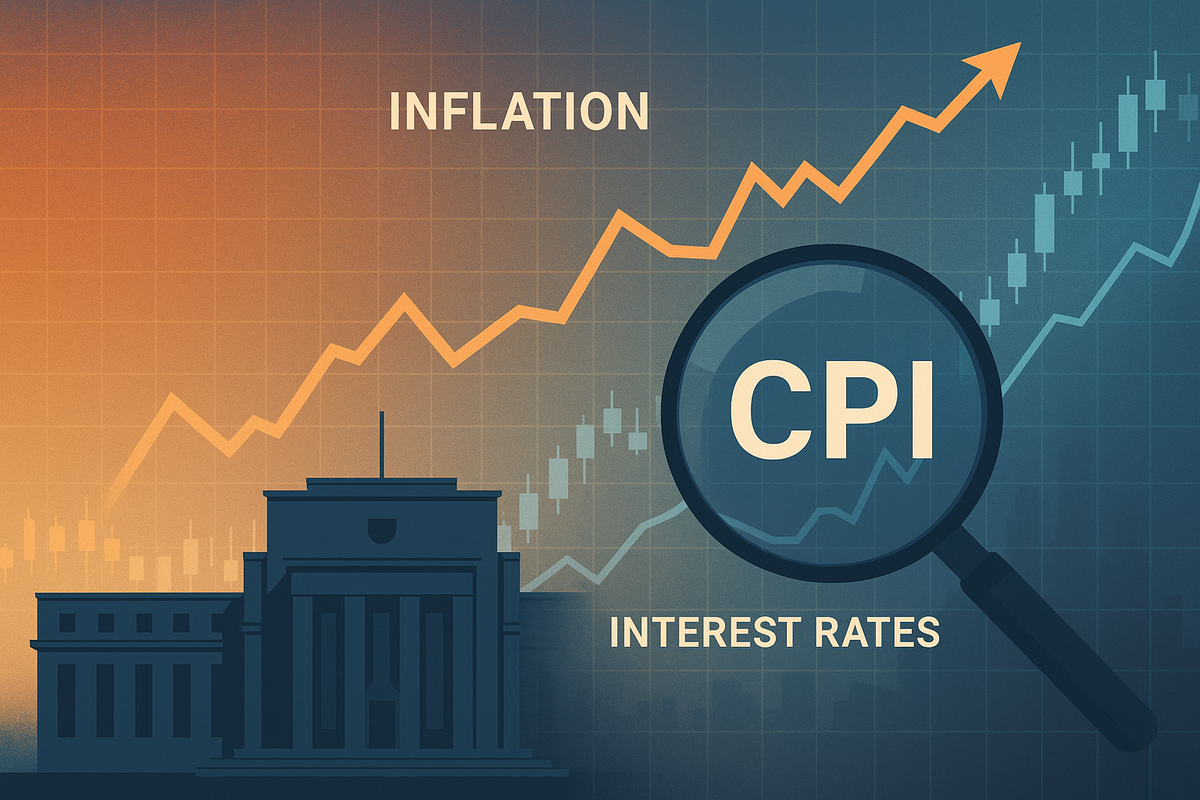
The financial markets are abuzz with renewed speculation of an impending Federal Reserve interest rate cut, following the release of the July 2025 Consumer Price Index (CPI) report. Despite a nuanced picture presented by the data, with headline inflation showing a milder-than-expected increase, investors are increasingly betting on lower borrowing costs. This anticipation is fueled by the belief that the central bank will prioritize economic stimulus, potentially ushering in a period of increased consumer spending and business investment.
The latest CPI figures, which revealed a 2.7% year-over-year increase in headline inflation, slightly below economists' projections, have become the focal point of this market shift. While "core" inflation, excluding volatile food and energy prices, surprisingly rose to 3.1%, the overall moderation in the headline figure, largely attributed to a significant drop in gasoline prices, has provided the market with the "ammunition" it needed to solidify rate cut expectations. This development suggests a potential pivot in the Federal Reserve's monetary policy, moving from a tightening stance to one aimed at bolstering economic growth.
CPI Data Unveils Nuance, Fuels Fed Pivot Hopes
The July 2025 CPI report delivered a mixed bag of inflation signals, yet its overall interpretation by the market has been decidedly dovish. The headline CPI, which includes all goods and services, registered a 2.7% year-over-year increase, remaining unchanged from the previous month and coming in slightly below the 2.8% rise anticipated by economists. This moderation was significantly influenced by a notable decline in gasoline prices, offering a reprieve to consumers and contributing to the softer overall inflation print.
However, a deeper dive into the report reveals that "core" CPI, which strips out the more volatile food and energy components to provide a clearer picture of underlying inflation trends, told a different story. Core CPI unexpectedly accelerated to 3.1% from 2.9% in June, marking its highest level in several months. This uptick was partly driven by tariff-sensitive goods, suggesting that some inflationary pressures persist beneath the surface. Despite this, the market appears to be "looking through" this core inflation uptick, focusing instead on the broader narrative of disinflation and signs of a cooling labor market.
The timeline leading up to this moment has been characterized by a period of aggressive monetary tightening by the Federal Reserve to combat persistent inflation. For months, the Fed has maintained a hawkish stance, emphasizing its commitment to bringing inflation down to its 2% target. However, recent economic indicators, including slower payroll growth, a slight increase in unemployment, and declining job openings, have hinted at a softening labor market. These signals, combined with the latest CPI data, are leading investors to believe that the Fed's dual mandate of price stability and maximum employment might now lean more towards supporting employment and growth. Key players in this unfolding scenario include Federal Reserve officials, who will be scrutinizing this data closely, as well as institutional investors and traders whose collective actions are driving market sentiment. Initial market reactions have been swift, with futures markets significantly boosting the probability of a quarter-point rate cut by the Fed at its September meeting, with odds reaching as high as 90% to 95%. This strong market conviction itself is now influencing expectations and behavior across the financial landscape.
Potential Winners and Losers in a Lower Rate Environment
A shift towards lower interest rates, as anticipated by the market, typically creates a distinct set of winners and losers across various sectors and companies. The expectation of reduced borrowing costs and a potential boost to economic activity can significantly impact corporate profitability and investor sentiment.
Potential Winners:
Companies that are highly sensitive to interest rates and consumer spending are poised to benefit significantly. The housing sector is a prime example. Homebuilders like D.R. Horton (NYSE: DHI) and Lennar Corporation (NYSE: LEN) could see increased demand as lower mortgage rates make homeownership more affordable, stimulating sales and construction activity. Similarly, real estate investment trusts (REITs) focused on residential properties, such as Equity Residential (NYSE: EQR), might experience a boost as lower rates can increase property valuations and reduce financing costs for new acquisitions.
The automotive industry is another sector that stands to gain. Companies like General Motors (NYSE: GM) and Ford Motor Company (NYSE: F) could see an uptick in vehicle sales as lower interest rates translate to more affordable car loans for consumers. This could also benefit auto parts suppliers and dealerships.
Furthermore, growth stocks and companies with high debt loads often thrive in a lower-rate environment. Technology companies, which often rely on borrowing for expansion and innovation, could see their financing costs decrease, improving their profitability. Companies like Microsoft (NASDAQ: MSFT) and Apple (NASDAQ: AAPL), while less debt-dependent, could still benefit from increased consumer spending and a more favorable economic backdrop that encourages investment in technology. Smaller, high-growth companies that are not yet profitable but require capital for expansion could also find it easier and cheaper to secure funding.
Potential Losers:
Conversely, certain sectors and companies may face headwinds in a lower interest rate environment. Financial institutions, particularly banks, often see their net interest margins (NIM) squeezed when rates fall. Banks like JPMorgan Chase & Co. (NYSE: JPM) and Bank of America Corporation (NYSE: BAC) generate a significant portion of their revenue from the difference between what they earn on loans and what they pay on deposits. Lower rates can reduce this spread, impacting their profitability. While loan demand might increase, the reduced margin per loan could offset some of these gains.
Utility companies and other dividend-paying stocks that are often favored for their stable income streams in a high-rate environment might become less attractive. As interest rates on bonds and other fixed-income investments decline, the relative appeal of dividend stocks as income generators can diminish, potentially leading to some capital outflow. Companies like NextEra Energy, Inc. (NYSE: NEE) or Duke Energy Corporation (NYSE: DUK), while still offering stable dividends, might see their stock prices pressured if investors seek higher returns elsewhere.
Finally, companies that have benefited from a strong dollar, which can weaken with lower interest rates, might face challenges. Exporters could see their goods become more competitive, but importers might face higher costs. Companies with significant international operations could experience currency translation losses if the dollar depreciates significantly.
Broader Implications and Industry-Wide Ripple Effects
The anticipated shift in the Federal Reserve's monetary policy, driven by the latest CPI data, carries significant broader implications for various industries and the wider economy. This event fits into a larger trend of central banks globally navigating the delicate balance between controlling inflation and fostering economic growth, especially in a post-pandemic world marked by supply chain disruptions and geopolitical tensions.
One of the most significant ripple effects will be felt across the financial services industry. Beyond the direct impact on bank margins, lower rates could spur a resurgence in mergers and acquisitions (M&A) activity as borrowing becomes cheaper for corporate takeovers. Investment banks like Goldman Sachs Group Inc. (NYSE: GS) and Morgan Stanley (NYSE: MS) could see an increase in advisory fees. Furthermore, the bond market will likely experience a rally, as existing bonds with higher yields become more attractive, and new bond issuances become cheaper for corporations and governments. This could lead to increased demand for fixed-income products and services.
The retail sector is also poised for a boost. Lower borrowing costs for consumers, particularly on credit cards and personal loans, could translate into increased disposable income and higher consumer spending. This would benefit a wide array of retailers, from large department stores like Walmart Inc. (NYSE: WMT) and Target Corporation (NYSE: TGT) to e-commerce giants like Amazon.com, Inc. (NASDAQ: AMZN). The increased consumer confidence stemming from a more accommodative monetary policy could also encourage discretionary spending, benefiting sectors like travel and leisure.
From a regulatory and policy perspective, a Fed rate cut could alleviate some of the pressure on fiscal policy. Governments might find it cheaper to finance their debts, potentially allowing for more fiscal stimulus or investment in infrastructure projects. However, it also raises questions about the long-term implications of sustained low interest rates, such as potential asset bubbles or increased moral hazard. Historically, periods of rate cuts have often followed economic slowdowns or crises, aiming to stimulate recovery. The current scenario, where a rate cut is anticipated despite relatively robust employment figures, suggests a proactive approach by the Fed to prevent a deeper downturn, or to simply normalize rates after a period of aggressive tightening. Comparisons can be drawn to periods in the early 2000s or post-2008 financial crisis, where rate cuts were used to inject liquidity and stimulate demand, though the underlying economic conditions and inflationary pressures differ.
The manufacturing sector could also see a positive impact. Lower borrowing costs for businesses can encourage capital expenditure, leading to investments in new machinery, technology, and expansion. This could boost demand for industrial goods and services, benefiting companies like Caterpillar Inc. (NYSE: CAT) and Honeywell International Inc. (NASDAQ: HON). Additionally, a potentially weaker dollar resulting from lower rates could make U.S. exports more competitive on the global stage, providing a tailwind for export-oriented manufacturers.
What Comes Next: Navigating the Shifting Sands
The market's strong conviction in an impending Federal Reserve rate cut sets the stage for a dynamic period ahead, with both short-term adjustments and long-term strategic considerations for businesses and investors.
In the short term, the immediate focus will be on the Federal Reserve's upcoming meetings, particularly the September gathering. Any official communication from Fed officials, including speeches or minutes from previous meetings, will be scrutinized for further clues regarding the timing and magnitude of potential rate cuts. Market volatility is likely to persist as investors react to every piece of economic data and central bank commentary. Companies will need to assess their immediate financing needs and potentially refinance existing debt at lower rates. Consumer-facing businesses should prepare for a potential uptick in demand as borrowing costs ease.
Looking at the long term, a sustained period of lower interest rates could reshape investment strategies and corporate planning. Businesses might pivot towards more aggressive expansion plans, leveraging cheaper capital for mergers, acquisitions, and research and development. This could lead to increased competition in certain sectors as companies vie for market share. For consumers, lower rates could encourage larger purchases, such as homes and cars, and potentially lead to a re-evaluation of savings and investment strategies, with a possible shift from fixed-income assets to equities in search of higher returns.
Potential strategic pivots or adaptations required include companies re-evaluating their capital structures, optimizing debt, and potentially increasing shareholder returns through buybacks or dividends if profitability improves. Industries that are highly sensitive to interest rates, such as real estate and automotive, may need to adjust their production and sales forecasts upwards. Conversely, financial institutions will need to adapt their business models to a lower net interest margin environment, potentially focusing more on fee-based services or expanding into new markets.
Market opportunities may emerge in sectors that are poised for growth in a lower-rate environment, such as technology, renewable energy, and consumer discretionary. Investors might seek out companies with strong balance sheets and clear growth trajectories that can capitalize on cheaper financing. However, challenges also loom. If the Fed cuts rates too aggressively, it could reignite inflationary pressures down the line, forcing a reversal in policy. There's also the risk of asset bubbles forming if liquidity becomes too abundant, leading to overvalued markets.
Potential scenarios and outcomes range from a "soft landing" where inflation gradually recedes, and the economy avoids a recession, to a more challenging environment if core inflation proves more persistent than anticipated, forcing the Fed to maintain a tighter stance for longer. Another scenario involves a "Goldilocks" outcome, where economic growth remains steady, and inflation continues to drift lower, creating an ideal environment for risk-taking and supporting asset prices. The market's current positioning suggests a strong leaning towards this Goldilocks scenario, but the path forward remains subject to evolving economic data and central bank decisions.
Conclusion: A Pivotal Moment for Markets
The July 2025 CPI report marks a pivotal moment for financial markets, solidifying expectations for a Federal Reserve interest rate cut and signaling a potential shift in the central bank's monetary policy stance. The key takeaway is that despite a hotter "core" inflation figure, the milder-than-expected headline CPI, coupled with signs of a cooling labor market, has provided investors with the conviction that lower borrowing costs are on the horizon. This belief is rooted in the anticipation that the Fed will prioritize supporting economic growth and employment, even if it means tolerating slightly elevated core inflation for a period, especially if it's perceived as transitory or policy-driven.
Moving forward, the market will be keenly assessing the Federal Reserve's actions and communications. The strong probability of a September rate cut, as priced in by futures markets, suggests that investors are largely confident in this trajectory. However, any deviation from this path, whether due to stronger-than-expected inflation data or a more hawkish stance from Fed officials, could trigger significant market volatility.
For investors, the coming months will require careful navigation. While lower rates generally favor growth stocks, real estate, and consumer discretionary sectors, the potential for squeezed margins in financial institutions and reduced appeal for traditional income stocks should also be considered. Diversification and a focus on companies with robust fundamentals will remain crucial. What investors should watch for in the coming months includes: further inflation reports (particularly the PCE index, which the Fed favors), labor market data (unemployment rates, job openings, wage growth), and, most importantly, the Federal Reserve's official statements and press conferences. The interplay of these factors will ultimately determine the pace and extent of any rate cuts and their lasting impact on the economy and public companies trading in the market. The current environment suggests a cautious optimism, but vigilance will be key as the market adapts to this evolving monetary policy landscape.





